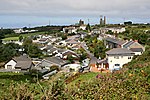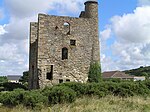Troon, Cornwall

Troon (Cornish: Trewoon) is a village in Cornwall, UK, 1+1⁄2 miles (2.5 kilometres) southeast of Camborne. The village lies at around 560 feet (170 m) above sea level. An electoral ward named Troon and Beacon covers the area north from Troon to the outskirts of Camborne. The population at the 2011 census was 5,410. There were once important copper and tin mines near Troon, including the Grenville Mines. Wheal Grenville began to be worked in the 1820s though it was not productive until the 1850s, at which time the South and East mines were worked independently. In 1906 these mines were united with South Condurrow to form the Grenville United Mines and continued until 1920. The mineral Condurrite is a compound mineral named after the Great Condurrow Mine at Troon.The King Edward Mine is still situated on the outskirts of the village on the Carn Brea Road. It has a museum and can still be visited. An inscribed altar stone found at Chapel Ia, Troon (now set in the altar of the parish church), and dated to the tenth or eleventh centuries, attests to the existence of a settlement then. The chapel of Saint Ia was recorded in 1429 and a holy well was nearby. The site was called Fenton-ear (i.e. the well of Ia). The stone is very similar to one now in the garden at Pendarves, used as the base for a sundial.There are two Cornish crosses at Pendarves; one was found in a ditch on the estate and then set up near the house. It has a crude crucifixus figure on the front and a Latin cross on the back. The other is a cross head found in the kitchen garden at Pendarves.
Excerpt from the Wikipedia article Troon, Cornwall (License: CC BY-SA 3.0, Authors, Images).Troon, Cornwall
Newton Road,
Geographical coordinates (GPS) Address Nearby Places Show on map
Geographical coordinates (GPS)
| Latitude | Longitude |
|---|---|
| N 50.2 ° | E -5.28 ° |
Address
Winding Engine House
Newton Road
TR14 9DP
England, United Kingdom
Open on Google Maps





